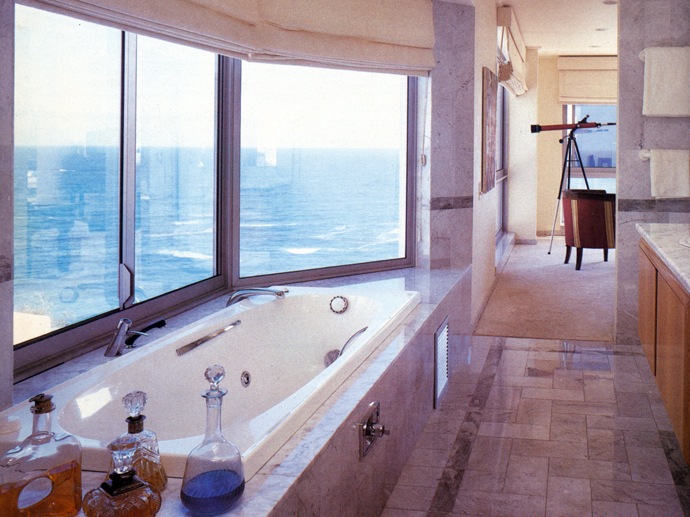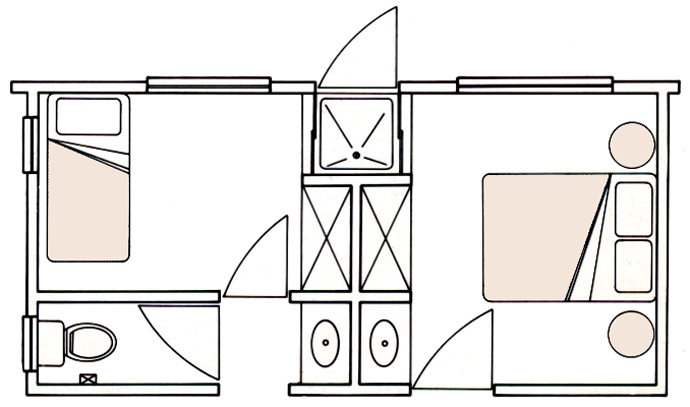How to Design Your New Bathroom

Designing a successful new bathroom involves far more than simply plumbing in the basic fixtures. The position of the room and its internal layout should be carefully considered at the planning stage, taking into account factors such as access, privacy, space, plumbing and traffic flow.
Locating the Bathroom
The position of a bathroom in relation to the other rooms of the house is extremely important, particularly when you are taking the trouble to design a new one. An inconveniently located bathroom not only affects the ease with which the household functions but can also detract from the resale value of the property.
On the other hand, if yours is an established bathroom in need of a facelift, you will probably have little choice but to accept its present location (although you could find ways of improving its efficiency and accessibility, such as knocking out an additional door to provide an instant en suite bathroom).
If you are planning a brand new bathroom, your options will be wider. The following aspects often influence where a bathroom is sited:
Plumbing A streamlined solution that keeps plumbing localised can cut costs considerably. It is common practice to place rooms that need water supplies and drains back to back (usually a kitchen on one side and one or more bathrooms on the other) so that they share the same plumbing wall. For this reason, many double-storey homes have bathrooms stacked above the kitchen. At the same time, however, it can be said that a less expensive, localised plumbing system is not necessarily always the best solution.
If you have a more flexible budget, try not to let plumbing considerations dictate to you. Instead, consider your long-term requirements in terms of the location of the bathroom, and plan accordingly. A little extra money spent on pipework now may save a great deal of frustration and discomfort later.
Access The bathroom is usually the first place that family members visit on waking in the morning and their last port of call before going to bed so if your bathroom is the only one in the house, or contains the only toilet, it will need to be placed in a position where it is easily accessible from all the bedrooms.
A family bathroom that can only be reached via another room is a potential source of irritation: a constant stream of bathroom-bound children through the lounge or bedroom will intrude on your privacy and leave a trail of soggy footprints across the carpet. En suite arrangements are ideal for houses with more than one bathroom because they are easily accessible from the bedrooms they serve and offer a degree of privacy not often found in communal bathrooms. A bathroom which is used exclusively by family members – such as a pair of teenagers – can even be positioned between two bedrooms so that it serves as an en suite arrangement for both. Access from the outside also needs to be considered. If for example, the bathroom is likely to be used as a change-room after swimming, an external door of some sort will obviate the need for people to walk, dripping, through the house.
At this point, it may be worthwhile sketching a rough plan of your house, pinpointing the various routes that people will take to reach the bathroom. This will allow you to isolate any access problems and to plan accordingly.
Privacy Everyone is entitled to privacy when using the bathroom. A guest cloakroom opening off a living room or facing the front door is too close to communal living areas for comfort: ideally, it should be placed out of earshot where it can be used without embarrassment.
Views, Ventilation and Sun Many bathrooms have small windows with frosted glass, the main purpose of which is to prevent passers-by from seeing in, but there is no reason why a bathroom shouldn’t have large, clear windows which look out over the garden or surrounding landscape. An upstairs bathroom can command uninterrupted views, but if yours is on the ground floor and overlooks the street you will need to find some way of ensuring a degree of privacy. Some modern bathrooms have windows opening onto plant-filled courtyards which not only screen the room but also provide the next best thing to a natural view. Similarly, there is nothing to prevent you from placing the bathroom on the sunniest side of the house. Bear in mind that a windowless bathroom will need efficient mechanical ventilation systems to rid it of steam and odours.

When Space is Limited
This plan shows how it is possible to incorporate en suite facilities for two adjacent bedrooms without having to spend a fortune on building an entirely new bathroom. The basins are placed back-to-back on the dividing wall (localised plumbing can cut costs considerably) and are separated from the shower by deep built-in cupboards. Sliding screens on the sides of the shower cubicle make it instantly accessible from both rooms, and an external door allows one to step straight into the cubicle from the outside. Admittedly, the bedroom on the right is deprived of an en suite toilet, but the fixture is nonetheless only a few steps away. An added advantage of this layout is that the toilet/basin area can also be used as a guest cloakroom when you design your new bathroom.
>
>
 SANS10400-Building Regulations South Africa SANS10400 are the Building regulations in South Africa, and both international and national standards, are fundamental to successful building and construction projects, both big and small.
SANS10400-Building Regulations South Africa SANS10400 are the Building regulations in South Africa, and both international and national standards, are fundamental to successful building and construction projects, both big and small.